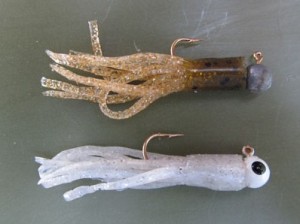 Many types of jigs are popular in freshwater fishing. This article explains a few of the most popular jig styles, rigs and jigging techniques.
Many types of jigs are popular in freshwater fishing. This article explains a few of the most popular jig styles, rigs and jigging techniques.
Types of Jigs
Shad darts are small jigs that are dressed with deer hair. These unique lures feature a simple head with an angled face. Shad darts usually have gold colored hooks which are thought to attract fish. These old school jigs come in sizes from about 1/4 oz. down to micro jigs of 1/32 oz.
Shad darts are casted and retrieved with a slow twitching motion to catch a variety of baitfish and panfish. They are also used to fish live baits such as small minnows.
Crappie jigs are old school lures that catch fish as well today as they did 100 years ago. These simple jigs employ a few wraps of body material and a simple marabou feather tail. Several patterns are popular with panfish anglers.
Bucktails jigs include some of the oldest and simplest lure designs. These jigs are available in sizes for any fishing situation, including lure weights from 1/16 oz. up to monster jigs that can weigh 1 pound or more.
Feather jigs are similar to bucktails, consisting of simple bird feathers, wraps of thread and some form of epoxy. Feather jigs range in sizes from 1/16 oz. and up.
Soft plastic body jigs are extremely popular. They utilize various styles of bare lead head jigs that accept a soft plastic body. Lure bodies come in countless sizes, shapes, colors and are even available scented.
The popularity of these jigs is due to several qualities. Soft bodies feel more natural, which means fish tend to bite and hold on to them longer than other jigs. Anglers also like these jigs because bodies can be changed in a flash, allowing experimentation of color, size, shape or other factors.
Metal jigs (spoons and slab jigs) come in a variety of styles, but most work on the same basic principle. Most metal jigs have a shape which causes them to flutter or wobble. Their metallic exterior can be polished or painted depending on angler choice.
Metal jigs are casted and retrieved in a variety of motions, or simply lowered and worked up and down the water column. Small versions are jigged vertically when ice fishing.
Spinner baits combine a jig with a rotating or fluttering blade. Models either incorporate an arm into the jig itself or use an metal arm which accepts a standard jig and spinner blade.
Special Rigs for Jigging
Twin rigs feature a pair of identical jigs rigged on a special leader. Twin rigs use a loop, crimp, or 3 way swivel as a means of connection.
Heavy – light tandem jigs can be useful when fishing in deep areas or where currents are swift. Getting lures into the strike zone requires weight in moving water, so pairing a heavy jig with a lighter version is one way to jig in deep areas.
Dropshot rigs are often used with jigs. They employ a bottom weight in tandem with a light lure on a branching leader. The bottom weight of a dropshot rig can be bounced along rocks or other structure while the lure is positioned in the strike zone.